


Understanding Crane Scales A Comprehensive Overview
Crane scales, a pivotal tool in various industrial sectors, are specialized weighing devices uniquely designed to measure the weight of heavy objects suspended from cranes or lifting mechanisms. These scales have become indispensable in industries such as construction, shipping, manufacturing, and logistics due to their accuracy, ease of use, and capability to handle significant weights.
At the heart of a crane scale is its ability to provide precise weight measurements while maintaining structural integrity under heavy loads. Typically, these scales consist of a hook for suspending the load, a load cell that converts the weight into an electrical signal, and a display unit that provides the readout. The technology used in crane scales can vary, from traditional mechanical systems to advanced digital models featuring wireless connectivity and sophisticated software.
One of the standout features of modern crane scales is their accuracy. Many advanced crane scales can measure weights up to several tons with precision down to a fraction of a kilogram. This accuracy is crucial for industries where safety and compliance with regulations are paramount. For instance, in construction, overloading a crane can lead to catastrophic failures, making it essential for operators to have precise weight data before moving heavy materials.

Crane scales are also lauded for their portability and versatility. Unlike traditional weighing scales that are fixed in one location, crane scales can be used in various settings and can easily be transported from one site to another. This mobility is particularly beneficial in industries where weights need to be measured on-site, such as in shipping yards or construction sites. Operators can quickly and efficiently weigh heavy loads without the need for specialized infrastructure.
Another key benefit of crane scales is their user-friendly design. Most modern crane scales are equipped with intuitive interfaces, allowing operators to obtain weight readings with minimal training. Features such as backlit displays enhance visibility, while additional functionalities, like tare weight adjustment and data logging, further improve the user experience. These advancements make crane scales accessible to a broader range of users, from seasoned professionals to newcomers in the field.
Furthermore, many crane scales now offer wireless capabilities, making it possible to transmit data to remote devices, such as smartphones or computers. This feature can streamline operations, particularly in busy environments where quick decisions are needed based on weight measurements. The ability to store and analyze data over time can also support operational efficiency and help businesses to optimize their processes.
In conclusion, crane scales represent a vital component in modern industrial operations. Their ability to accurately measure the weight of heavy objects, combined with user-friendly designs and advanced technology, enhances safety and productivity across various sectors. As industries continue to evolve and place a greater emphasis on efficiency and safety, the role of crane scales will only become more significant. Embracing these tools not only ensures the smooth operation of businesses but also safeguards personnel and equipment, making crane scales an invaluable asset in today’s weight-sensitive environments. Whether you are lifting steel beams on a construction site or handling bulky cargo in a shipping yard, investing in a high-quality crane scale is essential for achieving optimal results while maintaining safety standards.



